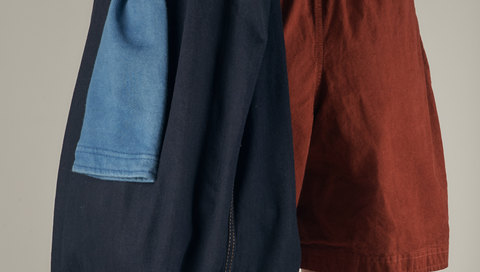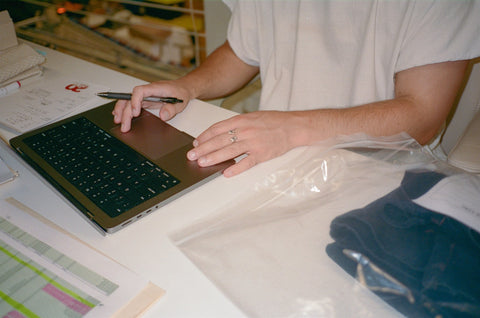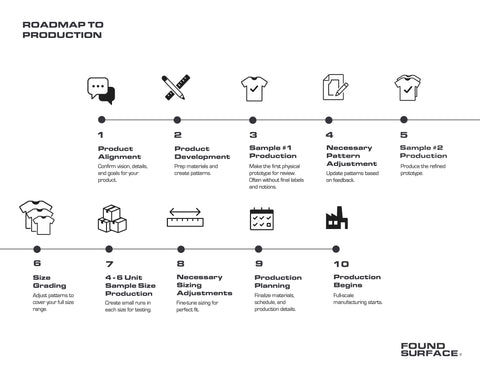Every building has a blueprint. Every garment should too.
In apparel development, that blueprint is called a tech pack. It’s the document that translates creative ideas into technical instructions, making sure everyone — from patternmakers to production teams — is working from the same playbook.
When tech packs are vague or incomplete, the process stalls. Miscommunication spreads. Samples miss the mark. Timelines stretch. Costs rise.
This article explains what a tech pack includes, why it’s so critical, and how to simplify the process so your development stays on track.
What Is a Tech Pack?
A tech pack (short for technical package) is the instruction manual for your garment. It captures all the details needed to build a product consistently, from the very first prototype through full-scale production.
It typically includes:
-
Flat Sketches or CADs: Clean visuals that show the garment from multiple angles.
-
Measurements & Specs: Dimensions for each size, including key points of measure.
-
Materials & Trims: Fabrics, linings, labels, buttons, zippers, and other details.
-
Construction Notes: Stitch types, seam finishes, and any special techniques.
-
Bill of Materials (BOM): A breakdown of everything required to build the garment.
-
Grading Rules (optional at early stages): How measurements scale across sizes.
Think of it as a universal language. A good tech pack eliminates ambiguity, so whoever picks it up — whether in development or production — knows exactly what to make.
Why Tech Packs Matter
Without a tech pack, development relies on assumptions. And assumptions are expensive.
The risks of skipping or rushing a tech pack include:
-
Misaligned Samples: The garment that arrives isn’t what was imagined.
-
Endless Rounds of Revisions: Each change requires new samples, adding time and cost.
-
Production Delays: Factories stall until instructions are clarified.
-
Quality Issues: Without construction notes, finishing varies and consistency suffers.
In short: if the tech pack is unclear, everything downstream slows down.
Common Mistakes in Tech Packs
-
Vagueness: “Slim fit” or “medium weight fabric” isn’t enough detail.
-
Overcomplication: A 40-page document of conflicting notes only creates confusion.
-
Incomplete References: Leaving out visuals or fabric swatches makes it guesswork.
-
One-Size-Fits-All Thinking: A tech pack for a hoodie looks different than one for a blazer — but many brands recycle templates without adjusting.
These mistakes lead to more questions than answers.
How to Simplify Your Tech Pack
The best tech packs are clear, not bloated. Here are five principles to simplify:
-
Start With Visuals: A flat sketch communicates faster than a paragraph.
-
Prioritize Key Measurements: Focus on points of measure that truly impact fit.
-
List Materials Early: The sooner fabric and trims are identified, the smoother development runs.
-
Be Consistent: Use the same format for every style to reduce confusion.
-
Update in Real Time: Don’t wait until the end — revise as changes are made so the pack always reflects the current garment.
How Tech Packs Save Time and Money
A clear tech pack is an investment. Spending an extra hour on documentation upfront can save weeks of rework later.
Consider two scenarios:
-
Without a tech pack: A sample arrives with the wrong neckline. A second sample uses the wrong fabric. A third still fits poorly. Each round means another delay.
-
With a tech pack: The sample arrives closer to expectation. Feedback is focused on fine-tuning, not fixing misunderstandings. Approval comes faster, with fewer samples.
That difference can mean months off a launch timeline and thousands saved in development costs.
Why In-House Tech Packs Make a Difference
Many factories expect brands to arrive with tech packs already completed. But most new brands don’t have the expertise or resources to build one from scratch.
That’s why creating tech packs in-house, alongside development, makes a difference. The same team that builds the pattern, samples, and production plan also writes the instructions. Nothing gets lost in translation.
The result: fewer revisions, shorter timelines, and garments that align with the original vision.
The Bigger Picture
A tech pack isn’t busywork. It’s a belief in structure. It’s a tool that creates speed by removing ambiguity. It protects budgets by preventing rework. It protects creativity by keeping vision intact.
The industry average is confusion. A modern approach is clarity. Tech packs are where that clarity begins.
Closing Thought
Think of a tech pack as the connective tissue of apparel development. It’s what ensures that every decision — from sketch to production — has a thread of consistency running through it.
For brands serious about scaling, a strong tech pack isn’t optional. It’s the blueprint for success.









